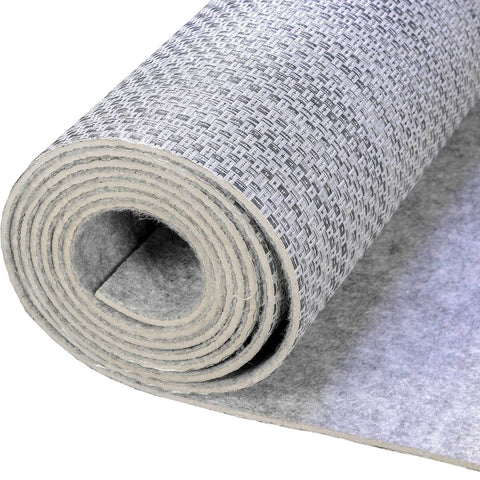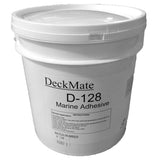$639.99
$576.99
Description:
Sensations by Syntec delivers comfort and durability you can afford. Available in our standard woven texture or woven teak, this beautiful pontoon flooring is soft to walk on, slip resistant and tough enough to last.
Syntec Woven Vinyl Flooring is stain resistant and easy to clean, making it much lower maintenance compared to carpet.
- 3000 hours of UV stability means your new flooring wont fall apart in the sun.
- Mold, mildew resistant marine grade vinyl.
- 140mil marine grade vinyl flooring.
Installation Tips
- Space your deck screws or bolts 16" apart when securing your decking.
- Apply adhesive to your deck using a medium nap paint roller.
- Use a roller or stiff broom to firmly press your new vinyl flooring down into the glue.
- Install your fence risers under each bolt that secures your railing to the deck.
- Cut the deck seam tape into 8' sections and lay it on top of the aluminum cross members connecting your tubes. The deck seam tape seals the joints where your plywood comes together, preventing water from working its way up under your woven vinyl flooring.
How To Replace Your Pontoon Flooring
- Check out our pontoon forum for complete pontoon restorations and learn how to replace the deck and carpet on your pontoon.
Q: How do I install new woven vinyl flooring on my pontoon boat?
A: In order to install your woven vinyl flooring, you must remove all of the old carpeting and adhesive from the deck of your pontoon. Also, it is important to fill any voids or delaminated areas on your existing deck with wood putty or fiberglass filler. If you do not remove the old carpet and glue or if you do not fill the voids in an existing deck you will feel the imperfections under the flooring and most importantly any left over adhesive may interact with the new glue, preventing it from bonding with the back of the woven vinyl.
If your deck is clean and the surface area is ready for the new woven vinyl flooring covering then read on, if you are having difficulty removing your old carpet please see below where we discuss the problems you may run into.
Before applying any glue to your deck, roll your new woven vinyl flooring out completely over the deck of your boat so that you can inspect it. Occasionally, woven vinyl flooring will have imperfections in it which we may miss or it can get damaged in shipping; now is the time to discover any problems. Do not glue your woven vinyl floor down before you inspect it. Call us immediately if you have any problems so that we can replace the woven vinyl flooring for you. Once you have the woven vinyl rolled out and it looks good, fold it in half the length of the deck. For example, if you have a 20' pontoon boat, get in the front of the boat and fold the woven vinyl over width-wise and do the same in the back, leaving a 4' wide by 20' long section of your deck exposed. Your woven vinyl flooring will be folded on top of itself on the other side of the deck so that you can apply glue to half of the decking.
By folding the floor covering this way it makes installation much easier, you can apply the glue by standing on the side of the pontoon, without needing to get on your hands and knees. Each gallon of glue will cover a 8' x 12' area, so if you have a 16-24' pontoon boat use one gallon per side, if you have a 25-30' pontoon you will need a total of 3 gallons of glue and will use 1-1/2 gallons per side. Take your first gallon and dump it evenly across the exploded 4' x 20' wide section of the deck. Using a medium nap paint roller spread the adhesive over the deck and make sure that there is full coverage with no empty areas. Be sure to spread glue as far into the center when the flooring is flipped to one side so you don't end up with any areas that are not covered with the glue. Once the glue is applied, lay the woven vinyl floor out over the entire deck and make sure it is flat and squared up. You will not have much time to work with the woven vinyl once you lay it on the glue, so be sure it is lined up on the deck properly before you begin applying the glue.
Next, you must compress the woven vinyl flooring onto the lines of glue. The polyester backing will bond to the glue when apply pressure, forming a bond which will hold the woven vinyl flooring in place once the glue hardens. Use a heavy roller, you can rent a carpet roller or use a heavy pipe to press the woven vinyl down onto the glue. This is the most important step, if you do not press the flooring down hard enough the glue and backing will not bond together, causing it to come up or creating lines and bubbles in your new pontoon flooring.
Q: How do I remove the old carpet? What if it doesn't come off easily or only comes off in small chunks?
A: If your pontoon boat is a 2000 model year or newer, you may experience difficulty when removing the carpet. Newer pontoon boats use a heavier carpeting and a stronger glue than was used in the 70's, 80's and early 90's. Boat builders applied special marine adhesives that provide excellent adhesion and heavier backed carpeting than you see on the older model pontoons. Also since these boats are newer, the carpet and glue have not deteriorated to the point where it is easy to remove them. On most older pontoon boats, the carpet will come off fairly easily with some scraping, cutting and tearing. If you find that your pontoon carpet is only coming off in small chunks and that you cannot seem to remove the old adhesive and fibers you can try renting a floor sander or simply replace the decking.
To remove the decking without taking up the carpet, if you choose to replace the flooring, here is how you do it. First, find the seams where the plywood decking meet up, take a razor knife and cut across the floor separating the carpet on each sheet of plywood. If the plywood deck is bolted down, cut the heads off the bolts under the deck and rip the decking off. If the deck is screwed down, use a hole saw and locate the screw heads, cut around each head and tear the decking off. Then use a sawzaw to remove the screws and plywood plugs that are left over. You may find that the cost of the plywood is worth it compared to the time and energy you will spend trying to remove carpet that won't come off.












